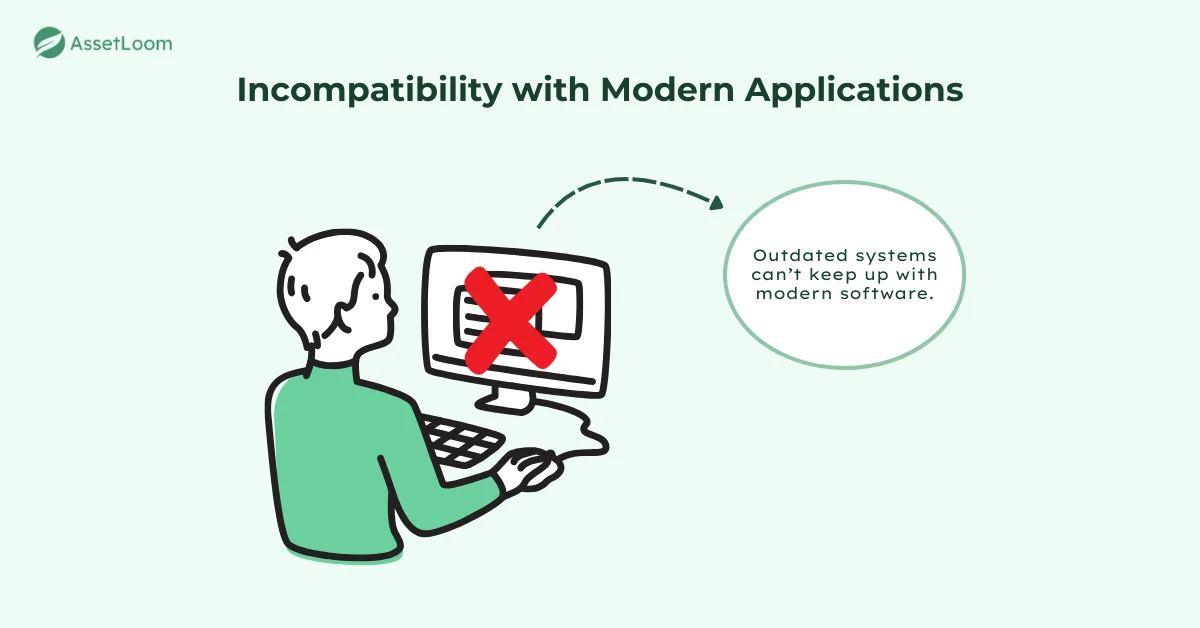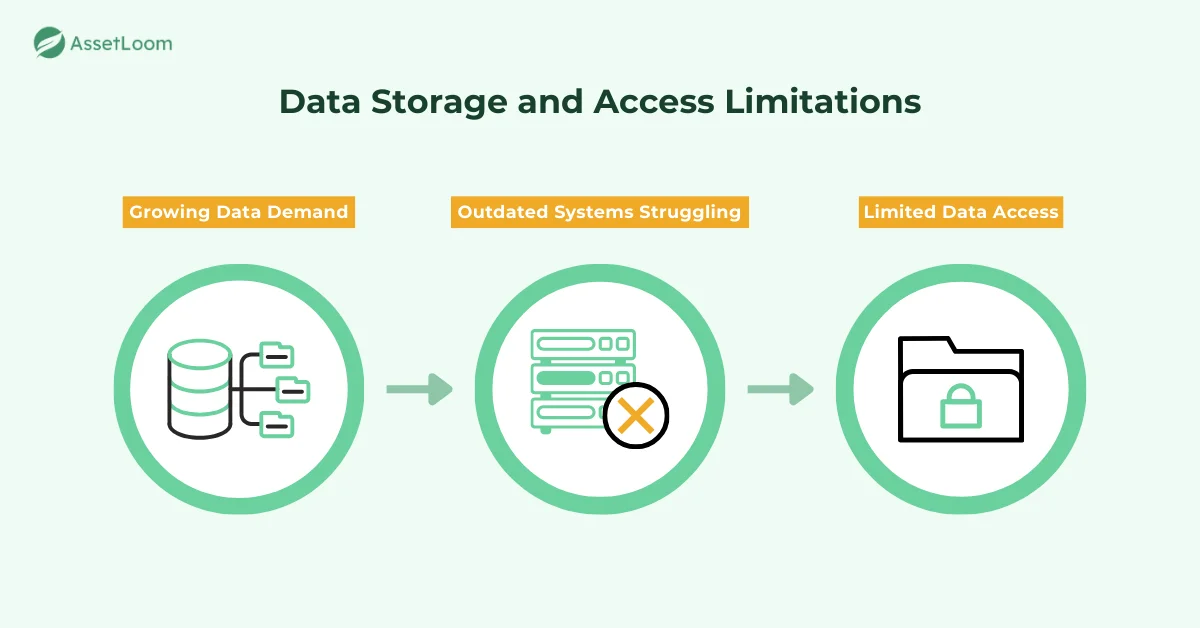10 Signs You’re Using Outdated Technology
Outdated technology slows productivity, increases costs, and adds risk. Discover 10 clear signs it’s time for an upgrade.
We have all experienced it: waiting too long for a system to load, dealing with sudden crashes in the middle of important work, or struggling to connect older tools with newer ones. It can be frustrating for employees, stressful for IT teams, and costly for the business.
Outdated technology does more than slow things down. It creates real risks, from higher maintenance costs to serious security gaps. The good news is that spotting the warning signs early can prevent bigger problems later.
In this article, we will look at ten clear signs that your technology is past its prime and why paying attention now can help your business run more smoothly.
1. Systems Run Slowly or Crash Frequently
Slow and crashing systems aren’t just frustrating; they impact productivity. When devices fail to perform at their best, work slows down, and tasks get delayed. Over time, these disruptions can lead to inefficiency and lost opportunities.
Why It Happens
Outdated hardware and bloated software are often the main causes. As systems age, their components wear down, and they struggle to handle the demands of modern workloads. Without proper IT asset lifecycle management, many businesses fail to track the performance and replacement schedules of their hardware, leading to unexpected slowdowns and failures.
The Hidden Costs
- Productivity loss: Time wasted waiting for slow systems to catch up.
- IT resource drain: IT teams spend excessive time fixing avoidable problems.
- Potential data loss: Unstable systems increase the risk of losing critical data.
What You Can Do
- Upgrade Hardware: Replace devices that are 3+ years old. Newer systems with better processors and SSDs can significantly improve performance.
- Optimize Software: Remove unnecessary programs and keep software up-to-date to avoid bloat.
- Clean Storage: Regularly clear out unnecessary files to help speed up access.
Quick Tip
If a full upgrade isn't an option, adding more RAM or switching to SSD storage can provide an immediate speed boost to older systems.
2. Incompatibility With Modern Applications
One of the most frustrating challenges that outdated systems create is the inability to support modern applications. As software evolves, it often requires newer hardware or updated operating systems. When your systems can’t keep up, it forces employees to use outdated tools that limit productivity and even hinder innovation.

Why It Happens
Legacy systems often can’t handle the requirements of modern software, whether it’s new applications, tools, or updates to existing programs. As software developers push the boundaries of what’s possible, older hardware and operating systems struggle to integrate or run these programs efficiently.
The Hidden Costs
- Productivity decline: Employees waste time dealing with software crashes or slow applications.
- Missed opportunities: Teams can’t take advantage of the latest tools and features that improve efficiency.
- Security risks: Older systems may not support the latest security patches needed to protect against vulnerabilities in new software.
What You Can Do
- Assess Software Needs: Regularly review your software and ensure that your hardware can support it. If your systems can’t handle key apps, it’s time to upgrade.
- Implement Compatibility Testing: Before rolling out new software across the organization, test it on your existing hardware to identify potential issues.
- Standardize Tools: Move towards standardized platforms or cloud-based solutions that work across multiple devices, reducing compatibility issues.
Quick Tip
Switching to cloud-based tools can eliminate many compatibility issues, as they are designed to work on almost any device with an internet connection, bypassing the need for frequent hardware upgrades.
3. Rising Maintenance and Support Costs
If you're noticing that maintaining and supporting your systems is costing more and more, it’s likely because your technology is outdated. Over time, older hardware and software require more frequent repairs, updates, and patches. These ongoing costs can quickly exceed the cost of replacing the technology entirely.
Why It Happens
As systems age, their components start to degrade, and software becomes less compatible with newer tools. Vendors stop providing updates, leaving your systems vulnerable to issues that become more difficult and expensive to fix.
The Hidden Costs
- Higher repair costs: Frequent breakdowns increase repair expenses.
- Decreased productivity: IT teams spend more time troubleshooting instead of focusing on new projects.
- Budget strain: Continuous fixes can drain your budget and still leave you with underperforming systems.
What You Can Do
- Implement a regular upgrade cycle: Replace hardware every 3-4 years to avoid excessive maintenance costs.
- Conduct routine system checks: Schedule regular performance and health checks to catch issues early and reduce unplanned downtime.
- Consolidate support contracts: If your technology is reaching end-of-life, explore consolidated service contracts to get better rates and predictability in repair costs.
Quick Tip
Don’t wait until systems fail completely. Planning ahead and budgeting for upgrades can help avoid sudden repair costs and ensure smoother transitions when you replace outdated technology.
4. Increased Security Vulnerabilities
Outdated systems pose a significant risk when it comes to security. As technology ages, it no longer receives critical security patches and updates from vendors. This leaves your systems exposed to new vulnerabilities, which can be exploited by cybercriminals, leading to data breaches, ransomware attacks, and other security issues.
Why It Happens
As software and hardware age, they fall behind in terms of modern security features. Vendors typically stop releasing security updates for older products, which means any new vulnerabilities discovered in the software or hardware go unpatched, leaving the system open to threats.
The Hidden Costs
- Increased risk of breaches: Old systems are prime targets for hackers looking for weak points.
- Legal and compliance issues: Failure to meet security standards can lead to compliance violations and costly fines.
- Brand reputation damage: A data breach can significantly damage your company's reputation and erode customer trust.
What You Can Do
- Update systems regularly: Ensure all systems are regularly updated with the latest security patches and software updates.
- Upgrade to newer hardware: Modern hardware comes with built-in security features such as encryption and more robust protection against attacks.
- Conduct regular security audits: Routinely assess your infrastructure for vulnerabilities and fix issues before they lead to breaches.
Quick Tip
If upgrading isn’t an immediate option, consider using patch management software along with security patches and antivirus software to reduce the risk of vulnerabilities. However, keep in mind that this is only a temporary fix.
5. Limited Scalability for Business Growth
As your business grows, so do its technological needs. Outdated systems can limit your ability to scale effectively. Whether it’s handling larger volumes of data, supporting more users, or integrating with new software, older technology often struggles to keep up with the demands of expansion. This can lead to bottlenecks, inefficiencies, and missed growth opportunities.
Why It Happens
Legacy systems are typically not designed to handle increased workloads or the evolving needs of a growing organization. As you add more devices, users, and applications, older hardware and software reach their limits, making it harder to expand your infrastructure or add new capabilities.
The Hidden Costs
- Bottlenecks: As systems become overloaded, performance slows down, leading to delays and frustrated employees.
- Missed opportunities: Outdated systems may not support the latest innovations, which can put your company behind competitors who are using more agile, scalable solutions.
- Inefficient resource allocation: With limited scalability, resources are stretched thin, and IT staff spend more time managing problems than enabling growth.
What You Can Do
- Migrate to scalable solutions: Consider cloud-based platforms or virtualization that allow for flexible scaling without major infrastructure changes.
- Plan for capacity growth: Regularly assess your system's performance to forecast future needs and ensure you have the capacity to handle growth.
- Consolidate systems: Reduce complexity by moving to integrated systems that can handle multiple functions (e.g., cloud-based ERP systems) instead of managing several disparate tools.
Quick Tip
Cloud solutions offer flexibility and scalability, allowing you to scale up (or down) based on demand without the need for constant hardware upgrades.
6. End-of-Life (EOL) Status From Vendors
When hardware or software reaches its End-of-Life (EOL), it no longer receives support, updates, or security patches from the vendor. Continuing to use EOL technology can expose your organization to increased risk, as unpatched vulnerabilities leave systems open to attacks. Additionally, relying on outdated tech can create compatibility issues with newer systems and software.
Why It Happens
Vendors discontinue support for older products to focus on newer technologies. As systems age and become obsolete, businesses that fail to replace or upgrade their equipment often find themselves stuck with unsupported technology, which becomes more difficult and expensive to maintain.
The Hidden Costs
- Increased security risks: EOL products don't receive security patches, making them vulnerable to cyberattacks.
- Compatibility issues: EOL systems may struggle to integrate with newer tools and software, leading to inefficiencies.
- Compliance concerns: For businesses in regulated industries, using EOL technology can lead to non-compliance with security or industry standards.
What You Can Do
- Track product lifecycles: Stay informed about the EOL dates for your critical hardware and software, and plan upgrades ahead of time.
- Replace or upgrade EOL systems: Prioritize replacing systems that have reached EOL status to avoid potential issues.
- Consider extended support contracts: If replacement isn’t immediately possible, some vendors offer extended support for EOL products, though this should be a temporary solution.
Quick Tip
Make upgrading a regular part of your IT strategy. Proactively replacing equipment before it reaches EOL will ensure your systems stay secure and compatible with new technologies.
7. Poor Integration With Modern Tools
Outdated technology often struggles to integrate with newer tools and software. In today's fast-paced business environment, seamless integration between systems is crucial for efficiency. If your hardware or software can’t communicate with modern solutions, it can create silos, force manual processes, and slow down your workflows.
Why It Happens
Legacy systems were not designed with modern integration in mind. Many older technologies lack support for APIs or cloud-based services, which makes it difficult to connect them with newer applications or systems. As a result, you may find yourself using workarounds or duplicating efforts just to keep things running.
The Hidden Costs
- Inefficiencies: Manual data entry or transferring information between incompatible systems wastes time.
- Increased error rates: The more manual steps involved in transferring data, the higher the likelihood of errors.
- Missed opportunities for automation: Without integration, you can’t take advantage of automated workflows that streamline business processes.
What You Can Do
- Adopt integrated platforms: Look for software and systems that are designed to work together, reducing the need for manual workarounds.
- Use cloud-based solutions: Cloud tools often provide better compatibility and integration options, making it easier to connect with other systems.
- Update legacy systems: Where possible, consider upgrading older systems to newer versions that support modern integration capabilities like APIs.
Quick Tip
Integrating middleware tools can also help connect older systems with newer platforms, allowing you to bridge the gap without completely replacing legacy technology.
8. Frequent Hardware Failures and Downtime
Frequent hardware failures and downtime are clear signs that your technology is outdated. Devices that overheat, crash, or require constant repairs take valuable time away from work and force your IT team to spend resources on temporary fixes rather than long-term solutions.
Why It Happens
As hardware ages, components like hard drives, power supplies, and cooling systems wear down. The longer you rely on outdated hardware, the more likely it is that critical parts will fail, leading to system instability and unplanned downtime.
The Hidden Costs
- Unplanned downtime: Critical work is delayed while systems are being repaired or replaced.
- Increased repair costs: Frequent breakdowns can be expensive, especially if replacement parts are no longer readily available.
- Lost productivity: Employees are unable to complete their tasks, leading to wasted time and missed deadlines.
What You Can Do
- Perform regular hardware checks: Monitor the health of your hardware and replace parts that are showing signs of wear.
- Replace aging hardware: If equipment is more than 3-4 years old and has started to fail regularly, consider replacing it to avoid ongoing maintenance costs.
- Invest in preventive maintenance: Schedule routine checkups to catch potential issues early before they lead to downtime.
Quick Tip
Investing in extended warranties for critical systems can provide peace of mind and help avoid costly repairs when systems begin to fail.
9. Data Storage and Access Limitations
As your data grows, outdated technology can struggle to keep up with the volume and speed at which information needs to be accessed and processed. Aging storage solutions, whether local servers or older databases, often lack the capacity and speed required to handle the demands of modern businesses.

Why It Happens
Older storage systems were not designed to manage the massive amounts of data generated by today’s digital operations. They often lack the scalability, speed, and redundancy features needed to ensure quick access to data and prevent loss. As data grows, these systems become slow, unreliable, and inefficient.
The Hidden Costs
- Slow data access: Employees waste time waiting for data to load or retrieve, which slows down workflows.
- Increased risk of data loss: Older storage systems are more vulnerable to failure, increasing the risk of losing critical data.
- Inability to scale: As the amount of data grows, older storage solutions can’t scale to meet business needs, forcing businesses to rely on inefficient workarounds.
What You Can Do
- Upgrade to modern storage solutions: Consider cloud-based storage or newer on-premise solutions that offer better scalability and faster access.
- Use data management tools: Implement tools that allow you to categorize and organize data efficiently, ensuring faster access and easier retrieval.
- Consider hybrid storage models: A mix of on-premise and cloud storage can give you the flexibility to scale as needed, with better reliability and speed.
Quick Tip
Implement data archiving solutions to move old, infrequently accessed data to cheaper, slower storage, freeing up space on your primary systems for critical data.
10. User and Customer Experience Declines
Outdated technology doesn’t just affect internal teams; it impacts the user experience too. Employees struggle with slow systems, while customers may experience delays or disruptions when interacting with your business. Whether it's lagging performance on your website, difficulty accessing customer support, or slow processing times for orders, outdated systems can lead to a poor experience across the board.
Why It Happens
As technology ages, it becomes more difficult to keep up with the demands of modern users. Systems that once worked fine may not be able to support the expectations of today’s customers or employees, who expect faster, smoother, and more reliable service. These outdated systems can’t support the latest technologies, which means your business falls behind competitors who are using more efficient solutions.
The Hidden Costs
- Customer dissatisfaction: Slow websites, delays in service, and poor user interfaces drive customers away.
- Employee frustration: Staff dealing with inefficient, unreliable systems are less productive and more likely to become disengaged.
- Revenue loss: Poor customer experience can result in lost sales and negative reviews, damaging your brand reputation.
What You Can Do
- Regularly assess user experience: Conduct usability testing and customer feedback surveys to identify pain points caused by outdated technology.
- Upgrade key systems: Focus on upgrading customer-facing systems such as your website, e-commerce platform, or customer support tools.
- Invest in better hardware and software: Ensure that internal systems used by employees are efficient and reliable to support fast, seamless service delivery.
Quick Tip
Improving website performance and online customer support systems can have an immediate impact on customer satisfaction, even if you're not able to upgrade everything at once.
Conclusion
Outdated technology doesn’t just slow things down; it costs time, money, and security. From constant maintenance to poor performance, sticking with old systems puts your business at a disadvantage.
By spotting the signs early and upgrading your tech, you can boost productivity, reduce risks, and stay competitive. Don’t wait for issues to pile up. Invest in the right technology now and set your business up for future success.

Subscribe for Expert Tips and Updates
Receive the latest news from AssetLoom, right in your inbox.

